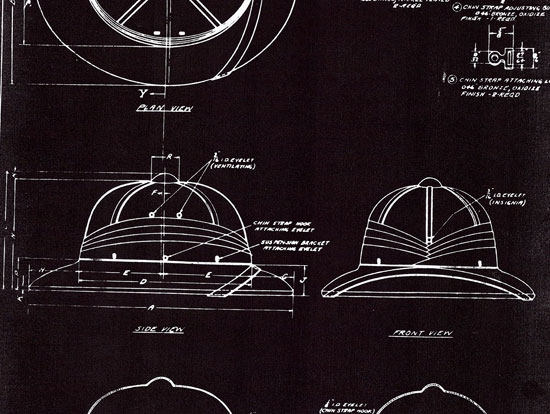 In the summer of 2017 a unique item (above) showed up at auction and this reporter was fortunate to obtain it – it appeared to be a press or form for the American pressed fiber sun helmet. Recently a reader explained to me exactly how this item was used, and now it confirms that this was in fact used by Hawley Products Company, the maker of the pressed fiber helmets. Continue reading
In the summer of 2017 a unique item (above) showed up at auction and this reporter was fortunate to obtain it – it appeared to be a press or form for the American pressed fiber sun helmet. Recently a reader explained to me exactly how this item was used, and now it confirms that this was in fact used by Hawley Products Company, the maker of the pressed fiber helmets. Continue reading
Tag Archives: Pressed Fiber Helmet
USMC Prototype?

At the recent Show Of Shows (SOS) in Louisville a fascinating helmet was found – and to say I’ve never seen anything like it would be an understatement. It appears to be a commercial/civilian sun helmet likely from the 1930s. It features a USMC EGA (Eagle/Globe/Anchor) stamp on the front, and the faint remnants of a USMC stamp on the inside rear visor. Continue reading
A Marine “Instructor” Fiber Helmet
 Our friends at the National Museum of the Marine Corps recently shared some photos of the above helmet. It is truly something we’ve never seen before. It was suggested that the unique triangular metal plate may have been worn to identify the owner as an “instructor” but more information isn’t available. Continue reading
Our friends at the National Museum of the Marine Corps recently shared some photos of the above helmet. It is truly something we’ve never seen before. It was suggested that the unique triangular metal plate may have been worn to identify the owner as an “instructor” but more information isn’t available. Continue reading
The Hawley Pressed Fiber Sun Helmet – Patented

It has been long established that there were two makers of the American pressed fiber sun helmet –Hawley Products and the International Hat Company. As we’ve previously noted, the USMC blueprints for the helmets dated back to the 1940s, however we’ve been provided with the original patents from 1935 and 1936. These were filed with the U.S. Patent Office by Jesse B. Hawley, the founder of Hawley Products and apparently the original inventor and patent holder of the Hawley sun helmet. Continue reading
The American Pressed Fiber Helmets Blueprints
The history of the American pressed fiber sun helmet continues to be one that remains shrouded in mystery. However, thanks to my friend and colleague Alex Tulkoff some information has come to light. Mr. Tulkoff recently uncovered original blueprints for the helmet and more importantly a May 1941 dated Quartermaster order, which offers some insight information about the costs of the helmets.
The Forgotten American Experimental Sun Helmet
 Following the end of the Second World War American military planners considered a number of replacements for the M1 steel helmet, yet it wasn’t until the late 1970s that the PAGST (Personnel Armor System for Ground Troops) was developed. It was made of Kevlar and was a major departure from the steel helmets that had been used since the First World War.
Following the end of the Second World War American military planners considered a number of replacements for the M1 steel helmet, yet it wasn’t until the late 1970s that the PAGST (Personnel Armor System for Ground Troops) was developed. It was made of Kevlar and was a major departure from the steel helmets that had been used since the First World War.
However, during the 1950s the American military also apparently considered a lightweight helmet for use tropical areas where the rays from the sun were often as much as a problem as enemy bullets. The helmet was never adopted and this author has only once even seen an example for sale. Continue reading
Tropical Disease and the History of Military Head Nets

An American Army tropical “Pressed Fiber” helmet and mosquito net from the Vietnam War era of the late 1960s (Author’s Collection)
The military sun helmet was introduced to save lives, not from bullets or even spears but from quite literally from the sun. The European soldiers – first the British but later the French, Belgian, Spanish, Portuguese and Germans – fell victim to sun stroke and heat stroke in their respective newly obtained colonies. The sun helmet offered protection from the sun and along with better tropical clothing likely helped save countless lives beginning in the second half of the 19th century.
The other problem facing soldiers as well as diplomats, colonists and workers was tropical disease. Among the most deadly was yellow fever. Even today in many tropical regions – especially Africa and South America – yellow fever continues to be a major problem. Today nearly a billion people live in an area of the world where the disease is common. Yellow fever originated in Africa but spread to South America through the slave trade in the 17th century, and since that time there have been major outbreaks in the Americas, Africa and even Europe. Continue reading

